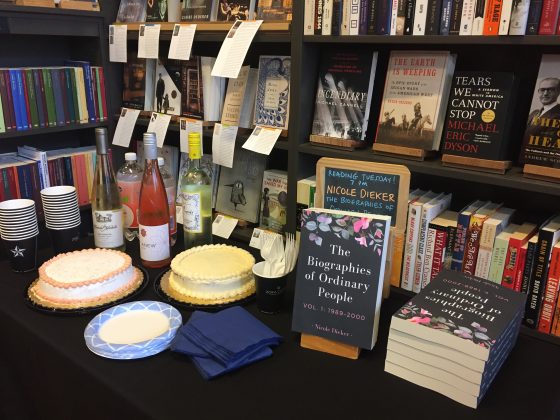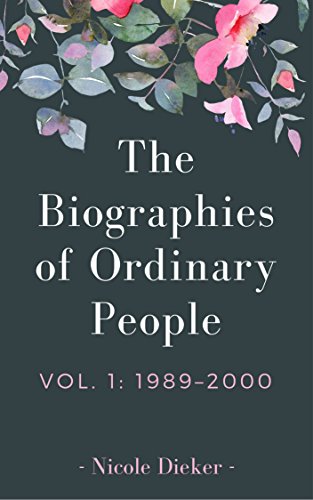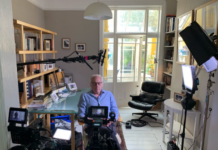- Honours even - 7th January 2026
- Football focus another trial - 6th January 2026
- A year to forget… - 5th January 2026

Today’s guest post is by freelancer and novelist Nicole Dieker (@hellothefuture).
On May 23, 2017, I self-published my debut novel: The Biographies of Ordinary People: Volume 1: 1989–2000. It’s a Millennial-era Little Women that follows three sisters from 1989 to the present; the second volume, which covers 2004–2016, will release in May 2018.
There’s a lot about my book that is, shall we say, extraordinary. (Someone had to.) I funded the drafts of both volumes through Patreon; 61 supporters contributed $6,909 over eighteen months in exchange for two draft chapters per week. I queried the first volume in the traditional publishing market, and after hearing multiple agents say that the writing was very strong but that the book was “too quiet” to be marketable, I started asking myself whether I could market the book on my own.
This wasn’t as ambitious an idea as it might seem; I was in my fifth year as a full-time freelance writer, which meant that I had a large network of media contacts and an established group of readers and followers. My freelance work also meant that I knew how to pitch and promote myself, and I had the social media outreach and community-building skills that come with contemporary freelancing.
Plus, I’d already “earned my advance” through Patreon. I knew that I had readers who were both excited about this book and willing to pay for it.
 So I spent several months researching the self-publishing process and planning my own marketing and publication strategy. It turns out that there’s a lot of information on how to self-publish a book, and a lot of advice regarding marketing, social media, and so on—but there aren’t as many case studies showing how well these publication strategies work.
So I spent several months researching the self-publishing process and planning my own marketing and publication strategy. It turns out that there’s a lot of information on how to self-publish a book, and a lot of advice regarding marketing, social media, and so on—but there aren’t as many case studies showing how well these publication strategies work.
Which is why I’m giving you my own case study. Everything I’ve done so far, along with the costs and the results.
I’ll start with the most important statistic first: as of this writing, I’ve sold 167 ebooks and 118 paperbacks, and my royalties and earnings total $803.90.
Here’s how I got there.
Social media
I currently have 3,439 Twitter followers, 1,303 Tumblr followers, and 20,000 Medium followers. (I’m also on Facebook, but it’s more of a personal space than a professional one, and I’m just starting to build a platform on Instagram.)
I’ve been actively promoting The Biographies of Ordinary People on all of my social media streams, first with the Patreon project and then with a weekly Medium column titled This Week in Self-Publishing, in which I quantify the publicity/marketing work I did over the past week and tally up my expenses.
Despite my large—or at least Medium-sized—platform, only a small percentage of these followers ended up buying my book. Like, less than one percent small. And, although I continue to actively promote my novel on my various social networks, I find that the same small group of people are always the ones liking, retweeting, and commenting. As much as I hate to admit it, the vast majority of my followers don’t seem to be paying that much attention to what I do.
That said, many of my readers are very supportive and have done the work of buying my book, sharing my book on social media, reviewing my book on Amazon and Goodreads, and requesting my book at their libraries. It’s worth noting that I didn’t find these readers through social media; they’re either part of my in-real-life social network or they follow my freelance writing on The Billfold or The Write Life. Which means that social media, in and of itself, isn’t as useful of a promotional tool as everyone makes it out to be? I’m not sure.
Email list
My TinyLetter has 105 subscribers and a 74% open rate. When I launched my TinyLetter, the majority of hits to my book’s sales page either came directly from TinyLetter or from my website; I no longer get hits to my book’s sales page through TinyLetter, probably because everyone on the list who wants to buy the book already has. I do, however, use the mailing list as a way to communicate upcoming readings and events.
The people who interact with me on TinyLetter are the same core group of supporters who interact with me on social media. Although my mailing list undoubtedly drove some sales, I’m still marketing to the same group of people who would very likely have bought the book through a Twitter link if it hadn’t been available through a TinyLetter one.
Professional editorial reviews
I paid $924 for three editorial reviews: Kirkus Indie Reviews, BlueInk Review, and Foreword Clarion Reviews. (I also submitted my book to Publishers Weekly, but they did not elect to review it.)
Foreword Clarion gave me five stars and called The Biographies of Ordinary People “deeply satisfying.” Kirkus and BlueInk also gave very positive reviews, and I was able to use sections of all three reviews in my promotional and marketing copy.
I’m not sure these editorial reviews increased my sales, but I’m pretty sure not having the reviews would have hurt my sales. A self-published literary fiction book needs a set of editorial reviews the same way it needs a good cover or a well-designed interior. It’s just part of the package. (However, if you’re writing genre or more commercial fiction, it may not be worth the cost.)
Book blogger reviews
I reached out to 17 book bloggers who were actively requesting literary fiction books for review and got two responses. I’ve heard that it’s a lot harder to get book blogger reviews than it used to be; the most popular bloggers are inundated by review requests, and self-published authors are also competing with traditional publishers that can offer advance review copies of the hottest new book.
It’s also harder to get book blogger reviews because so many book blogs are abandoned or dead; I scrolled through lists of “best book blogs” and “most popular bookstagrammers” only to find that at least half of them were now defunct.
One of the bloggers who agreed to read my book lived in the UK, so I spent $38.87 to send her a paperback copy. Many of the bloggers I contacted preferred paperbacks, which I am happy to provide but which is also an additional expense; every time I purchase a case of 20 books from IngramSpark, for example, it costs me $156.90.
When I start doing pre-release work for Volume 2, I’m going to skip the individual pitches to book bloggers and pay to put my book on NetGalley instead. I skipped NetGalley this time around because it isn’t cheap—it costs $699 for a six-month listing plus a space in the NetGalley Newsletter—but I’d like to figure out how I can make it worth the listing fee.
Media placement
I was able to write articles and guest posts about The Biographies of Ordinary People for five different publications, all of which were already part of my freelance network. I also appeared on four podcasts. (If you’re interested in the emotional side of my self-publication process, you should should read the essay I wrote for The Awl: Never Write a Novel With an En-dash in the Title.)
I can directly correlate sales bumps to nearly every post or podcast. They aren’t very large bumps—two sales here, five sales there—and I’m guessing that’s for two reasons: first, because I was still working within my established network, and second, because I was writing more about the publication process than about my book. This attracts a slightly different audience: writers instead of readers. Not that writers aren’t readers, but they aren’t reading these types of posts to find new books to buy; they’re reading them to learn how to sell their own.
Bookstore appearances
So far, I’ve been able to book three bookstore appearances:
- A well-attended launch at Seattle’s Phinney Books
- An August 4 reading at Portland’s Another Read Through
- An August 11 event at Missoula’s Fact & Fiction that also features author Kayla Cagan and musicians Marian Call and Seth Boyer
I also tried to book a reading in New York City, but got turned down by every bookstore I contacted.
The Phinney Books launch cost me $207.10 to put together, which includes the celebratory cake and wine and the “co-hosting honorarium” I paid musician/podcaster Molly Lewis to record the event and lead the Q&A. Phinney Books has sold 15 copies of Biographies so far; most of them at the event, plus a few to people who couldn’t make it to the book launch but still wanted to buy their copy from Phinney Books. (We love our independent bookstores in Seattle.)
The Another Read Through event cost $40 in event fees and $140.27 in book printing and shipping costs. Like many indie bookstores, Another Read Through accepts self-published books on consignment: I pay to get the books printed and shipped to the bookstore and we share the profits. There’s also the cost of getting to Portland, which is $40 roundtrip by bus, and I still have to figure out whether I’m providing snacks.
The Fact & Fiction event has cost me a $214.40 plane ticket to Missoula and a $97.37 hotel room so far; there will also be a $60 Lyft ride to and from the airport, meals on the trip, and we’ll very likely have snacks at the event.
I’m giving you all of these numbers to illustrate that I’m not making any profit on bookstore appearances; I’d have to sell 50 books at the Fact & Fiction event just to cover the cost of the hotel. But doing readings is a good way to connect with readers and to support an independent bookselling community—plus it gives you a lot of great photos to put on social media.
Bookstore distribution
Even though I just wrote about the importance of supporting indie bookstores, I haven’t yet started to focus on bookstore distribution. I do have a list of bookstores that I’m planning to reach out to—all indies—and I hope that my sales history, my appearance history, and my reader reviews will help convince them that The Biographies of Ordinary People would be a good addition to their shelves.
I anticipate that I’ll be fronting a lot of consignment costs as I send my book out for distribution, and that I won’t necessarily make a lot of money—which is why I’m going to be strategic about the bookstores I choose and not try to paper the entire country with my paperbacks. If my book becomes popular enough that additional bookstores want to distribute it, they know how to contact Ingram Book Group.
Library distribution
I published my ebook through Pronoun, which offers library distribution through both OverDrive and Bibliotheca; I also signed up for distribution through Library Journal’s Self-E program.
My readers have also been reaching out to their home libraries and requesting my book, and I keep getting emails and social media messages letting me know that another library has elected to stock my paperback. The Multnomah County Library in Portland recently started lending my book, which I find particularly touching because that was my first library as a child.
Library distribution, like the use of libraries themselves, has come at no cost to me—and it gives readers who might not buy the book the chance to read it, which I appreciate.
Awards
I’ve submitted The Biographies of Ordinary People to be considered for three awards:
- The Foreword Indies, because I already know that Foreword likes my book
- The BookLife Prize, because Publishers Weekly is an industry leader
- The Pulitzer, because they are specifically looking for large-scale literary fiction about American life (and yes, they accept self-published novels)
I also plan to submit to the Independent Publisher Book Awards and the Independent Book Publishers Association Benjamin Franklin Awards.
So far, I’ve spent $228 on award submission costs, plus $34.43 to ship my books to the Foreword Indies and the Pulitzer; I’ll spend another $300 on the IPPYs and the IBPA awards, plus shipping.
I won’t know any of the awards results until next summer, although I have already gotten my Critic’s Report from The BookLife Prize, which includes the following blurb that I can use in my book marketing:
Dieker writes with unrepentant honesty about the human condition, crafting the story of the Gruber family with subtle narrative tension and the central claim that every life is worthy of a biography.
And yes, after sharing that blurb, I got a few new sales.
Advertising
I’ve spent $637.80 on advertising; I sponsored the Seattle Review of Books twice, and was in the BookExpo issue of the New York Review of Books’ Independent Press Listing.
The New York Review of Books approached me almost immediately after my five-star Foreword Clarion review, and I was flattered by both the source and the invitation. I hadn’t yet realized that having a well-reviewed book—and/or having enough money to pay for editorial reviews—meant that I would be approached by multiple publications looking to fill advertising slots. (I have turned all subsequent invitations down.)
I don’t believe the NYRB advertisement resulted in any sales, even with the BookExpo distribution. The first Seattle Review of Books sponsorship correlated with a little over 20 sales, and the second sponsorship correlated with 5 sales. I didn’t earn enough to pay for the cost of the ad in either case, but my sponsoring the Seattle Review of Books is more of a community-building thing, the same way that reading at indie bookstores is a community-building thing. I’m not in it to earn money; I’m in it so we can both get more readers.
Giveaways
I ran one Goodreads Giveaway, during which I gave away five signed paperbacks. I followed the advice I had seen online and made my giveaway global, which meant that I spent $126.83 to ship books literally around the world.
My Goodreads Giveaway completed very recently, so I haven’t seen any reviews from the giveaway winners yet. (Reviews aren’t guaranteed, but people who receive giveaway copies often choose to leave reviews.)
I do plan on running another Goodreads Giveaway on Volume 1 shortly before Volume 2 releases, but I will probably limit entrants to the U.S. and Canada to avoid another $100+ shipping bill.
Paid email promotions
I paid $35 for a BargainBooksy promotion that included my book in a daily email sent to 93,000 readers interested in literary fiction.
This has been my single most effective marketing tool. On the day the email went out, my Amazon sales ranking hit #16,507, which is the highest it’s been since the day I announced the pre-order. My sales ranking stayed at or just below that level for two days as people continued to open the email and purchase the book. I never made it into the Top 100 in any category, although I did make it to #120 in Literary Sagas.
The campaign correlated with 28 sales and $75.18 in royalties, which means it’s the first marketing tool that’s actually earned a return on investment. (It also means that being at #120 in the Literary Sagas category doesn’t necessarily mean selling that many books.)
I’m allowed to run one BargainBooksy campaign per month, and I have already marked my calendar for the next one. I also want to take advantage of similar email promotions like the ones offered by Reading Deals, BookSends, The Fussy Librarian, and—of course—BookBub.
BargainBooksy was the first big out-of-network step for me; the people who ordered my book online were already fans and followers, and the people who will attend my readings are likely to know me in some aspect. It’s clear that I need to continue to work out-of-network if I want my sales to grow, which means I need to do some more strategizing.
What have I learned?
Maybe that this is what success looks like for a debut literary fiction novel from a self-published author with a medium-sized online platform. The only thing that hasn’t been successful about this process are the (relatively) low sales; the editorial reviews have been great, the reader reviews have been great, the bookstores are happy to host me, the libraries are happy to stock me, and nearly everyone who’s read the book so far has asked me how soon they can read the second one.
When I started my “how to self-publish” research project a year ago, I knew that it was going to be a volume game—which is one of the reasons why I divided my novel into two volumes. The more books you publish, the better you get at the publication process; you also make more sales, in theory, because now you have a backlist.
I’ll publish The Biographies of Ordinary People: Volume 2: 2004–2016 next May, and I’m already excited to see how I can revise my publication strategy. I don’t see myself spending less money—I’m still going to purchase editorial reviews and buy cases of books—but I do see myself spending less time on stuff like “checking book blogs to see if they’re still active.” The biggest work I need to be doing right now is expanding my readership, because that’s what’s going to keep Volume 1 sales active until it’s time to release Volume 2.
After that, I guess I’ll have to figure out what to write next.









